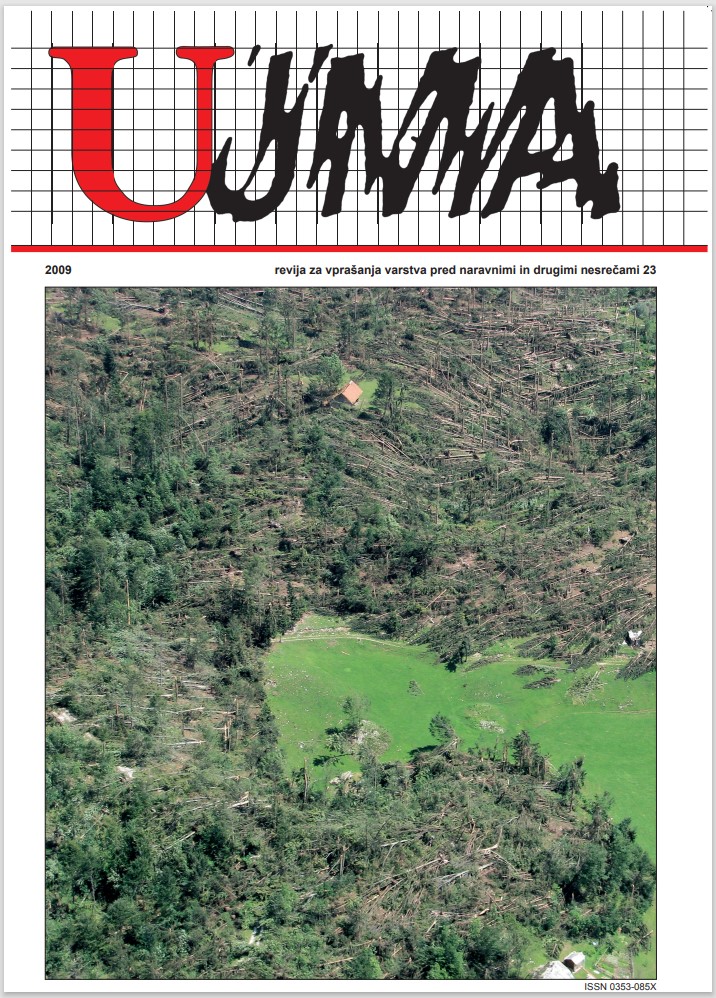NATO SfPS PROJECT: ASSESSMENT OF SEISMIC SITE AMPLIFICATION AND BUILDING VULNERABILITY IN MACEDONIA, CROATIA AND SLOVENIA
Abstract
The NATO Science for Peace and Security program project entitled Assessment of seismic site amplification and building vulnerability in Macedonia, Croatia and Slovenia (2005-2008) aimed at investigating the effects of local geological structures on seismic ground motion and building vulnerability using the microtremor method. This method enables estimation of the fundamental frequency of soft sediments which are deposited on a rocky basement and the two main building frequencies. The danger of soilstructure resonance can be thus established, as this can enhance damage to buildings in the case of an earthquake. The microtremor method enables quantitative seismic microzonation of urban areas. In Slovenia investigations were carried out in Ljubljana, the Bovec basin and the Ilirska Bistrica region. As part of the project an international workshop The increasing seismic safety by combining engineering technologies and seismological data was organized and a book published by Springer publisher. The results of the project will be published in a special issue of the Bulletin of Earthquake Engineering.
References
Bard, P. Y., 1999. Microtremor measurements: a tool for site effect estimation? V: Irikura, K., Kudo, K., Okada, H., Sasatami, T. (ur.): The effects of surface geology on seismic motion. Balkema, 1251—1279.
Gosar, A., 2007a. Microtremor HVSR study for assessing site effects in the Bovec basin (NW Slovenia) related to 1998 Mw5.6 and 2004 Mw5.2 earthquakes. Engineering geology, 91, 178—193.
Gosar, A., 2007b. Raziskave vpliva lokalne geološke zgradbe na potresno nihanje tal in ranljivosti objektov z mikrotremorji. Geologija, 50/1, 65—76.
Gosar, A., 2008a. Site effects study in a shallow glaciofluvial basin using H/V spectral ratios from ambient noise and earthquake data; the case of Bovec basin (NW Slovenia). Journal of Earthquake Engineering, 12, 17—35.
Gosar, A., 2008b. Raziskave resonance med tlemi in stavbami v Bovški kotlini z metodo mikrotremorjev. Ujma, 22, 17—178.
Gosar, A., Martinec, M., 2009. Microtremor HVSR study of site effects in the Ilirska Bistrica town area (S. Slovenia). Journal of Earthquake Engineering, 13, 50—67.
Gosar, A., Rošer J., Šket-Motnikar, B., Zupančič, P., 2009. Microtremor study of site effects and soilstructure resonance in the city of Ljubljana (central Slovenia). Bulletin of Earthquake Engineering (v tisku).
Gosar, A., Lenart, A., 2009. Mapping the thickness of sediments using microtremors in the Ljubljana Moor basin (Slovenia). Bulletin of Earthquake Engineering (v tisku).
Mucciarelli, M., Herak, M., Cassidy, J. (ur.), 2009. Increasing seismic safety by combining engineering technologies and seismological data. Springer, NATO science for peace and security series C. Environmental security, 382 str.
Mucciarelli, M., Gallipoli, M. R., Šket-Motnikar, B., Zupančič, P., Gosar, A., Prevolnik, S., Herak, M., Stipčević, J., Herak, D., Milutinović, Z., Olumceva, T., 2009. Empirical estimates of dynamic parameters on a large set of European buildings. Bulletin of Earthquake Engineering (v tisku).
Nakamura, Y., 1989. A method for dynamic characteristics estimation of subsurface using microtremor on the ground surface. Q. R. Railway Tech. Res. Inst., 30, 25—33.
SESAME, 2004. Guidelines for the implementation of the H/V spectral ratio technique on ambient vibrations: measurements, processing and interpretation, 62 str., http://sesame-fp5.obs.ujf-grenoble.fr/Delivrables/Del-D23-HV_User_Guidelines.pdf
Downloads
Published
Issue
Section
License

This work is licensed under a Creative Commons Attribution-NonCommercial-NoDerivatives 4.0 International License.
The articles are made available to the public under Creative Commons Attribution-NonCommercial-NoDerivatives 4.0 International (CC BY-NC-ND 4.0).


